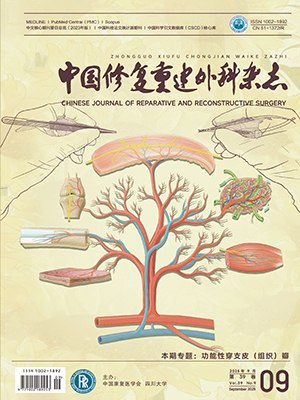| 1. |
左良, 喻建军, 周晓, 等. 游离股前外侧Kiss皮瓣修复巨大头皮恶性肿瘤术后缺损. 中国修复重建外科杂志, 2018, 32(3): 346-349.
|
| 2. |
张兴, 吴攀峰, 李诚, 等. 旋股外侧动脉及其分支类型的数字解剖学研究. 中国临床解剖学杂志, 2024, 42(5): 535-542.
|
| 3. |
Laungani AT, Van Alphen N, Christner JA, et al. Three-dimensional CT angiography assessment of the impact of the dermis and the subdermal plexus in DIEP flap perfusion. J Plast Reconstr Aesthet Surg, 2015, 68(4): 525-530.
|
| 4. |
陆浩, 薛明宇, 王进, 等. 数字化与3D打印技术辅助设计逆转旋髂浅动脉皮瓣接力修复股前外侧皮瓣供区8例. 中华显微外科杂志, 2023, 46(2): 168-173.
|
| 5. |
陈芝武, 林光豪, 於恩兴, 等. 定位膜联合CTA辅助设计股前外侧穿支皮瓣修复足和踝关节周围软组织缺损的临床应用. 中华显微外科杂志, 2023, 46(6): 625-630.
|
| 6. |
Gazyakan E, Xiong L, Sun J, et al. Vein grafting in microsurgical lower extremity reconstruction: Outcome analysis of primary versus secondary salvage procedures. J Reconstr Microsurg, 2021, 37(7): 608-616.
|
| 7. |
徐永清, 唐举玉, 刘元波, 等. 股前外侧皮瓣穿支解剖学特征与定位方法的专家共识(2024版). 中国临床解剖学杂志, 2024, 42(5): 489-499.
|
| 8. |
唐举玉, 孙念哲, 吴攀峰, 等. 股前外侧穿支皮瓣的个性化精准设计: 十年1079例临床疗效分析. 中国临床解剖学杂志, 2024, 42(5): 510-516.
|
| 9. |
金文虎, 张子阳, 吴祥奎, 等. 旋股外侧动脉嵌合皮瓣在足踝部复杂创面中的应用. 中国修复重建外科杂志, 2021, 35(7): 891-895.
|
| 10. |
战杰, 孙鹏, 吴锦生, 等. 分叶股前外侧穿支皮瓣在四肢软组织缺损修复中的应用. 中国临床解剖学杂志, 2024, 42(5): 564-569.
|
| 11. |
Zhang YX, Hayakawa TJ, Levin LS, et al. The economy in autologous tissue transfer: Part 1. The kiss flap technique. Plast Reconstr Surg, 2016, 137(3): 1018-1030.
|
| 12. |
徐庆, 吴双江, 吴剑, 等. 聚醚醚酮定位标志物联合混合现实技术在股前外侧穿支皮瓣血管定位中的应用研究. 中国修复重建外科杂志, 2024, 38(12): 1499-1504.
|
| 13. |
Shen Y, Huang J, Dong MJ, et al. Application of computed tomography angiography mapping and located template for accurate location of perforator in head and neck reconstruction with anterolateral thigh perforator flap. Plast Reconstr Surg, 2016, 137(6): 1875-1885.
|
| 14. |
周飞亚, 张弦, 蔡乐益, 等. 精准定位的微型股前外侧穿支皮瓣修复手指中等面积皮肤软组织缺损的效果. 中华烧伤与创面修复杂志, 2024, 40(2): 165-171.
|
| 15. |
张月恒, 崔文举, 宋坤修, 等. 改良CT血管造影术辅助基于浅筋膜穿支的股前外侧皮瓣穿支评估与偏心设计的前瞻性研究. 中华烧伤与创面修复杂志, 2023, 39(2): 141-149.
|
| 16. |
卿黎明, 贺继强, 唐举玉, 等. 基于活体造影数据的股深动脉穿动脉穿支血管的数字解剖学研究. 中国临床解剖学杂志, 2016, 34(1): 12-15.
|
| 17. |
Godina M, Arnez ZM, Lister GD. Preferential use of the posterior approach to blood vessels of the lower leg in microvascular surgery. Plast Reconstr Surg, 1991, 88(2): 287-291.
|
| 18. |
王丹莹, 刘元波, 陈威威, 等. CT血管造影预估近端蒂股前外侧皮瓣血管蒂长度的临床应用研究. 中国修复重建外科杂志, 2022, 36(3): 322-328.
|
| 19. |
王石, 董帅, 曹阳, 等. 高选择性动脉吲哚菁绿造影在游离股前外侧皮瓣设计中的应用. 中华烧伤与创面修复杂志, 2024, 40(10): 948-954.
|
| 20. |
赵海福, 方柏荣. choke血管血流动力学及血管重构的研究进展. 中华整形外科杂志, 2022, 38(1): 109-114.
|




